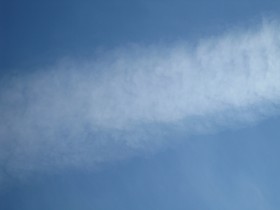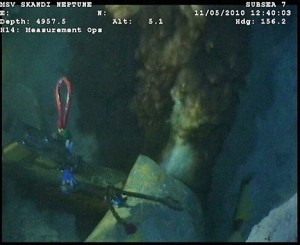Daniela Perdomo, Alter Net

Transocean making $ 270 millions off the oil spill.
It’s been 37 days since BP’s offshore oil rig, Deepwater Horizon, exploded in the Gulf of Mexico. Since then, crude oil has been hemorrhaging into ocean waters and wreaking unknown havoc on our ecosystem — unknown because there is no accurate estimate of how many barrels of oil are contaminating the Gulf.
Though BP officially admits to only a few thousand barrels spilled each day, expert estimates peg the damage at 60,000 barrels or over 2.5 million gallons daily. (Perhaps we’d know more if BP hadn’t barred independent engineers from inspecting the breach.) Measures to quell the gusher have proved lackluster at best, and unlike the country’s last big oil spill — Exxon-Valdez in 1989 — the oil is coming from the ground, not a tanker, so we have no idea how much more oil could continue to pollute the Gulf’s waters.
The Deepwater Horizon disaster reminds us what can happen — and will continue to happen — when corporate malfeasance and neglect meet governmental regulatory failure.
The corporate media is tracking the disaster with front-page articles and nightly news headlines every day (if it bleeds, or spills, it leads!), but the under-reported aspects to this nightmarish tale paint the most chilling picture of the actors and actions behind the catastrophe. In no particular order, here are 10 things about the BP spill you may not know and may not want to know — but you should.
1. Oil rig owner has made $270 million off the oil leak
Transocean Ltd., the owner of the Deepwater Horizon rig leased by BP, has been flying under the radar in the mainstream blame game. The world’s largest offshore drilling contractor, the company is conveniently headquartered in corporate-friendly Switzerland, and it’s no stranger to oil disasters. In 1979, an oil well it was drilling in the very same Gulf of Mexico ignited, sending the drill platform into the sea and causing one of the largest oil spills by the time it was capped… nine months later.
This experience undoubtedly influenced Transocean’s decision to insure the Deepwater Horizon rig for about twice what it was worth. In a conference call to analysts earlier this month, Transocean reported making a $270 million profit from insurance payouts after the disaster. It’s not hard to bet on failure when you know it’s somewhat assured.
2. BP has a terrible safety record
BP has a long record of oil-related disasters in the United States. In 2005, BP’s Texas City refinery exploded, killing 15 workers and injuring another 170. The next year, one of its Alaska pipelines leaked 200,000 gallons of crude oil. According to Public Citizen, BP has paid $550 million in fines. BP seems to particularly enjoy violating the Clean Air and Clean Water Acts, and has paid the two largest fines in the Occupational Safety and Health Administration’s history. (Is it any surprise that BP played a central, though greatly under-reported, role in the failure to contain the Exxon-Valdez spill years earlier?)
With Deepwater Horizon, BP didn’t break its dismal trend. In addition to choosing a cheaper — and less safe — casing to outfit the well that eventually burst, the company chose not to equip Deepwater Horizon with an acoustic trigger, a last-resort option that could have shut down the well even if it was damaged badly, and which is required in most developed countries that allow offshore drilling. In fact, BP employs these devices in its rigs located near England, but because the United States recommends rather than requires them, BP had no incentive to buy one — even though they only cost $500,000.
SeizeBP.org estimates that BP makes $500,000 in under eight minutes.
3. Oil spills are just a cost of doing business for BP
According to the Harte Research Institute for Gulf of Mexico Studies, approximately $1.6 billion in annual economic activity and services are at risk as a result of the Deepwater Horizon disaster. Compare this number — which doesn’t include the immeasurable environmental damages — to the current cap on BP’s liability for economic damages like lost wages and tourist dollars, which is $75 million. And compare that further to the first-quarter profits BP posted just one week after the explosion: $6 billion.
BP’s chief executive, Tony Hayward, has solemnly promised that the company will cover more than the required $75 million. On May 10, BP announced it had already spent $350 million. How fantastically generous of a company valued at $152.6 billion, and which makes $93 million each day.
The reality of the matter is that BP will not be deterred by the liability cap and pity payments doled out to a handful of victims of this disaster because they pale in comparison to its ghastly profits. Indeed, oil spills are just a cost of doing business for BP.
This is especially evident in a recent Citigroup analyst report prepared for BP investors: “Reaction to the Gulf of Mexico oil leak is a buying opportunity.”
4. The Interior Department was at best, neglectful, and at worst, complicit
It’s no surprise BP is always looking out for its bottom line — but it’s at least slightly more surprising that the Interior Department, the executive department charged with regulating the oil industry, has done such a shoddy job of preventing this from happening.
Ten years ago, there were already warnings that the backup systems on oil rigs that failed on Deepwater Horizon would be a problem. The Interior Department issued a “safety alert” but then left it up to oil companies to decide what kind of backup system to use. And in 2007, a government regulator from the same department downplayed the chances and impact of a spill like the one that occurred last month: “[B]lowouts are rare events and of short duration, potential impact to marine water quality are not expected to be significant.”
The Interior Department’s Louisiana branch may have been particularly confused because it appears it was closely fraternizing with the oil industry. The Minerals Management Service, the agency within the department that oversees offshore drilling, routinely accepted gifts from oil companies and even considered itself a part of the oil industry, rather than part of a governmental regulatory agency. Flying on oil executives’ private planes was not rare for MMS inspectors in Louisiana, a federal report released Tuesday says. “Skeet-shooting contests, hunting and fishing trips, golf tournaments, crawfish boils, and Christmas parties” were also common.
Is it any wonder that Deepwater Horizon was given a regulatory exclusion by MMS?
It gets worse. Since April 20, when the Deepwater Horizon oil rig exploded, the Interior Department has approved 27 new permits for offshore drilling sites. Here’s the kicker: Two of these permits are for BP.
But it gets better still: 26 of the 27 new drilling sites have been granted regulatory exemptions, including those issued to BP.
5. Clean-up prospects are dismal
The media makes a lot of noise about all the different methods BP is using to clean up the oil spill. Massive steel containment domes were popular a few weeks ago. Now everyone is touting the “top kill” method, which involves injecting heavy drilling fluids into the damaged well.
But here’s the reality. Even if BP eventually finds a method that works, experts say the best cleanup scenario is to recover 20 percent of the spilled oil. And let’s be realistic: only 8 percent of the crude oil deposited in the ocean and coastlines off Alaska was recovered in the Exxon-Valdez cleanup.
Millions of gallons of oil will remain in the ocean, ravaging the underwater ecosystem, and 100 miles of Louisiana coastline will never be the same.
6. BP has no real cleanup plan
Perhaps because it knows the possibility of remedying the situation is practically impossible, BP has made publicly available its laughable “Oil Spill Response Plan” which is, in fact, no plan at all.
Most emblematic of this farcical plan, BP mentions protecting Arctic wildlife like sea lions, otters and walruses (perhaps executives simply lifted the language from Exxon’s plan for its oil spill off the coast of Alaska?). The plan does not include any disease-preventing measures, oceanic or meteorological data, and is comprised mostly of phone numbers and blank forms. Most importantly, it includes no directions for how to deal with a deep-water explosion such as the one that took place last month.
The whole thing totals 600 pages — a waste of paper that only adds insult to the environmental injury BP is inflicting upon the world with Deepwater Horizon.
7. BP is sequestering survivors and taking away their right to sue
With each hour, the economic damage caused by Deepwater Horizon continues to grow. And BP knows this.
So while it outwardly is putting on a nice face, even pledging $500 million to assess the impacts of the spill, it has all the while been trying to ensure that it won’t be held liable for those same impacts.
Just after the Deepwater explosion, surviving employees were held in solitary confinement, while BP flacks made them waive their rights to sue. BP then did the same with fishermen it contracted to help clean up the spill though the company now says that was nothing more than a legal mix-up.
If there’s anything to learn from this disaster, it’s that companies like BP don’t make mistakes at the expense of others. They are exceedingly deliberate.
8. BP bets on risk to employees to save money — and doesn’t care if they get sick
When BP unleashed its “Beyond Petroleum” re-branding/greenwashing campaign, the snazzy ads featured smiley oil rig workers. But the truth of the matter is that BP consistently and knowingly puts its employees at risk.
An internal BP document shows that just before the prior fatal disaster — the 2005 Texas City explosion that killed 15 workers and injured 170 — when BP had to choose between cost-savings and greater safety, it went with its bottom line.
A BP Risk Management memo showed that although steel trailers would be safer in the case of an explosion, the company went with less expensive options that offered protection but were not “blast resistant.” In the Texas City blast, all of the fatalities and most of the injuries occurred in or around these trailers.
Although BP has responded to this memo by saying the company culture has changed since Texas City, 11 people died on the Deepwater Horizon when it blew up. Perhaps a similar memo went out regarding safety and cost-cutting measures?
Reports this week stated that fishermen hired by BP for oil cleanup weren’t provided protective equipment and have now fallen ill. Hopefully they didn’t sign waivers.
9. Environmental damage could even include a climatological catastrophe
It’s hard to know where to start discussing the environmental damage caused by Deepwater Horizon. Each day will give us a clearer picture of the short-term ecological destruction, but environmental experts believe the damage to the Gulf of Mexico will be long-term.
In the short-term, environmentalists are up in arms about the dispersants being used to clean up the oil slick in the Gulf. Apparently, the types BP is using aren’t all that effective in dispersing oil, and are pretty high in toxicity to marine fauna such as fish and shrimp. The fear is that what BP may be using to clean up the mess could, in the long-term, make it worse.
On the longer-term side of things, there are signs that this largest oil drilling catastrophe could also become the worst natural gas and climate disaster. The explosion has released tremendous amounts of methane from deep in the ocean, and research shows that methane, when mixed with air, is the most powerful (read: terrible) greenhouse gas — 26 times worse than carbon-dioxide.
Our warming planet just got a lot hotter.
10. No one knows what to do and it will happen again
The very worst part about the Deepwater Horizon calamity is that nobody knows what to do. We don’t know how bad it really is because we can’t measure what’s going on. We don’t know how to stop it — and once we do, we won’t know how to clean it up.
BP is at the helm of the recovery process, but given its corporate track record, its efforts will only go so far — it has a board of directors and shareholders to answer to, after all. The U.S. government, the only other entity that could take over is currently content to let BP hack away at the problem. Why? Because it probably has no idea what to do either.
Here’s the reality of the matter — for as long as offshore drilling is legal, oil spills will happen. Coastlines will be decimated, oceans destroyed, economies ruined, lives lost. Oil companies have little to no incentive to prevent such disasters from happening, and they use their money to buy government regulators’ integrity.
Deepwater Horizon is not an anomaly — it’s the norm.



 project, which involved trying to pump tens of thousands of gallons of mud, shredded rubber tires and other “junk” into the hole to try to halt the outflow of oil.
project, which involved trying to pump tens of thousands of gallons of mud, shredded rubber tires and other “junk” into the hole to try to halt the outflow of oil.

